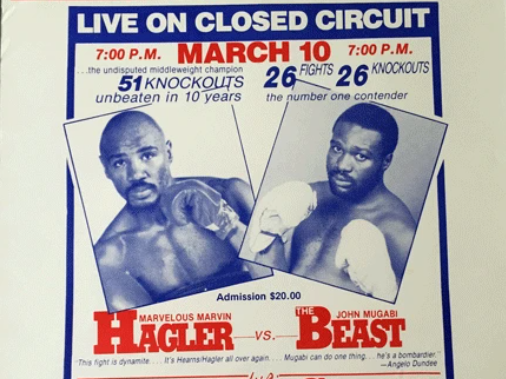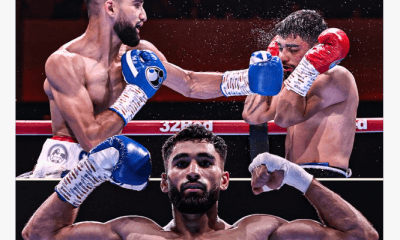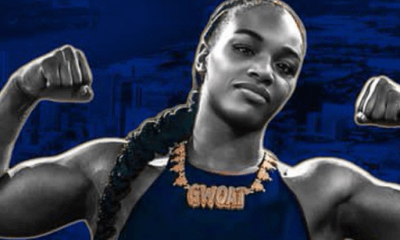Featured Articles
When ‘The Beast’ Ruled Boxing in Tampa

When ‘The Beast’ Ruled Boxing in Tampa
A week from Sunday, the fifty-fifth Super Bowl will be played in Tampa, Florida. At various times, the city on the west coast of America’s third-most-populous state had a vibrant boxing scene. This was especially true in the mid-1980s when a fighter from Uganda, of all places, was embraced by the locals and made the turnstiles hum. A poll in the Tampa Bay Times named John Mugabi the fourth-most-notable athlete in the Bay region following Lee Roy Selmon and James Wilder, standouts with the Tampa Bay Buccaneers, and golfer Gary Koch.
They called John Mugabi “The Beast.” When he fought Frank “The Animal” Fletcher before an SRO crowd in 1984, the event was dubbed “Wild Kingdom.” But we’re getting ahead of ourselves.
For a city like Tampa to become a boxing hub, the first pre-requisite is a tenacious promoter who is addicted to the sport. In Tampa, that man was the late John Alessi Sr. whose wholesale bakery and delicatessen, in the Alessi family since 1906, was a local institution. (Alessi’s chief lieutenant, Brad Jacobs, would remain in boxing and is currently the COO with Bob Arum’s Top Rank organization.)
Alessi had a veiled helpmate in Dr. Ferdie Pacheco who parlayed his role as Muhammad Ali’s personal physician into a gig as NBC’s director of boxing and ringside analyst. Boxing’s Renaissance man, Pacheco grew up in Ybor City, the Tampa neighborhood founded by Cuban immigrant cigar makers of Spanish descent. Although Pacheco settled in Miami, Ybor City was never far from his heart. He never missed an opportunity to go back and hold court at the historic Columbia restaurant where he had worked as a waiter as a teenager. When an NBC fight emanated from Tampa, Pacheco’s invisible hand was at work.
An Olympic silver medalist, John “The Beast” Mugabi was 14-0 when his British manager Mickey Duff brought him to Tampa in 1983 for a match with Indiana’s Gary Guiden. Mugabi knocked him out in the third round and Guiden, who was 39-6 heading in, never fought again.
This would be the first of John Mugabi’s nine fights in Tampa where he wound up purchasing a home. His bouts with Curtis Parker, James “Hard Rock” Green, the aforementioned Frank Fletcher, and Earl Hargrove were noteworthy.
Mugabi vs. Curtis Parker (Nov. 12, 1983)
They met at Tampa’s Sun Dome on a Saturday afternoon in a match nationally televised on NBC with the Tampa Bay area blacked out. A Philadelphia man, Parker was 24-4 heading in and had never been knocked off his feet, let alone stopped. But Mugabi had Parker fighting off his back foot from the opening gong and knocked him down twice before the bout was stopped in the opening frame.
Mugabi vs. James Green (Feb. 18, 1984)
They met on a Sunday afternoon at Tampa’s Hyatt Regency Hotel where Alessi potted many of his shows. The bout was buttressed by a strong undercard. Future heavyweight title-holders Bonecrusher Smith and Trevor Berbick were on the card, as was Mugabi’s stablemate Cornelius Boza-Edwards whose bout the previous year with Bobby Chacon was named The Ring magazine Fight of the Year. NBC televised only Mugabi’s fight.
“Hard Rock” Green, who came up the ladder in Atlantic City, was a rough customer, better than his 18-3 record would indicate. In the second round, Mugabi took a thumb in the eye, compromising his vision. That was seemingly a big advantage for the muscular five-foot-five Green as “The Beast” had never fought beyond six rounds, but Mugabi persevered and took Green out in the 10th.
This fight before a raucous SRO crowd was the early favorite for Fight of the Year, but would be edged out by the rematch between Edwin Rosario and Jose Luis Ramirez.
Frank Fletcher (Aug. 5, 1984)
“Wild Kingdom,” another Sunday afternoon affair on NBC, was contested at Tampa’s Egypt Shrine Temple before another SRO crowd. Frank “The Animal” Fletcher was on the comeback trail after getting stopped in a middleweight title elimination match by Juan Domingo Roldan.
Mugabi stalked Fletcher and caught up with him in the fourth round, blasting him out with a four-punch combination. “The Animal” had one more fight before leaving the sport with an 18-6-1 record.
Earl Hargrove (March 17, 1985)
This St. Patrick’s Day card on NBC, yet another sellout, was billed as the “Shootout at the OK Corral.” Between them, Mugabi and Hargrove had 49 knockouts in 50 fights. Hargrove was 26-1, his lone defeat coming in a world title fight with Mark Medal.
Mugabi had a habit of beating up on Philadelphia fighters and Earl Hargrove, who came out blazing, would suffer the same fate as Parker and Fletcher, only quicker. Mugabi dismissed him in 109 seconds. The fight didn’t last as long as ring announcer Mark Biero’s pre-fight introductions.
—
Mugabi’s braintrust had been angling for a fight with WBC 154-pound title-holder Thomas Hearns, but Hearns wanted no part of him, bypassing “The Beast” for matches with Roberto Duran and Fred Hutchings. Ergo, Mugabi set his sights on middleweight kingpin Marvin Hagler. They met in the outdoor arena at Caesars Palace on a soggy evening, March 10, 1986. Hagler was making his 11th title defense.
Mugabi was 25-0 with all of his wins coming by stoppage. Only nine of his opponents had lasted beyond the second round. Against Hagler, he was a beast but Marvelous Marvin was the more beastly beast. The fight ended in the 11th round with the Ugandan on the seat of his pants after eating two crushing right hands.
There were some doubts about Mugabi despite his eye-popping record. In defeat, Mugabi dispelled many of those doubts. The fight was competitive through 10 heats with Mugabi trailing by only one point on the scorecard of Dave Moretti. When Hagler left the ring, said LA Times sportswriter Jim Murray, “his face looked like a sack of plums.” Said Hagler’s manager Pat Petronelli, “Marvin’s whole body hurts.”
After this fight, Mugabi dropped back to 154 and fought Duane Thomas, a Kronk Gym fighter, for the vacant 154-pound belt. The fight was stopped in the third round after Mugabi turned his back on the referee, unable to see out of his left eye, which he claimed had been thumbed. Then, after taking off all of 1987, Mugabi won the 154-pound title in his second crack at it with a first-round stoppage of Rene Jacquot in Paris. (The lightly-regarded Jacquot had won the belt from Donald Curry in what was truly an astounding upset.)
The belt was at stake on Dec. 5, 1986, when Mugabi opposed Terry Norris at the Sun Dome in what would be his final appearance in Tampa. The 22-year-old Norris, trained by up-and-comer Abel Sanchez at a compound on a California ranch situated by the Mexican border, gave the Beast a taste of his own medicine, stopping him in the opening round before a stunned crowd that stood around for an hour after the fight trying to figure out what had just happened.
One hard punch from Norris and Mugabi turned into a zombie. He fought as if he were sleepwalking, which he blamed on pills that he had taken for itching a few hours before the fight. He said he did not know the name of the pills which were provided to him by a doctor in England and which he consumed without anyone knowing.
The final blow to John Mugabi’s reputation came at Prince Albert Hall in London where he was knocked out in the opening round by Gerald McClellan. Five years after this setback he popped up in Australia where he had a series of small fights before quitting the sport for keeps.
John “The Beast” Mugabi had 50 pro fights in all, winning 42, but like so many boxers he left the sport with little to show for it. An illiterate who never learned to read and write, he was easy prey for the finaglers, of which there are more than a few lurking about in professional boxing. He now lives in Brisbane where he hangs out at the gym where Jeff Horn and Dennis Hogan train while picking up side jobs as a personal trainer.
It has been written that in Brisbane, Mugabi is anonymous; when he walks the streets, no one recognizes him. That’s quite a comedown for a boxer who was once the Toast of the Town in Tampa.
Check out more boxing news on video at the Boxing Channel
To comment on this story in the Fight Forum CLICK HERE
-

 Featured Articles3 weeks ago
Featured Articles3 weeks agoResults and Recaps from New York Where Taylor Edged Serrano Once Again
-

 Featured Articles7 days ago
Featured Articles7 days agoThe Hauser Report: Zayas-Garcia, Pacquiao, Usyk, and the NYSAC
-

 Featured Articles3 weeks ago
Featured Articles3 weeks agoResults and Recaps from NYC where Hamzah Sheeraz was Spectacular
-

 Featured Articles4 weeks ago
Featured Articles4 weeks agoFrom a Sympathetic Figure to a Pariah: The Travails of Julio Cesar Chavez Jr
-

 Featured Articles2 weeks ago
Featured Articles2 weeks agoManny Pacquiao and Mario Barrios Fight to a Draw; Fundora stops Tim Tszyu
-

 Featured Articles3 weeks ago
Featured Articles3 weeks agoPhiladelphia Welterweight Gil Turner, a Phenom, Now Rests in an Unmarked Grave
-

 Featured Articles2 weeks ago
Featured Articles2 weeks agoArne’s Almanac: Pacquiao-Barrios Redux
-

 Featured Articles4 weeks ago
Featured Articles4 weeks agoCatterall vs Eubank Ends Prematurely; Catterall Wins a Technical Decision























